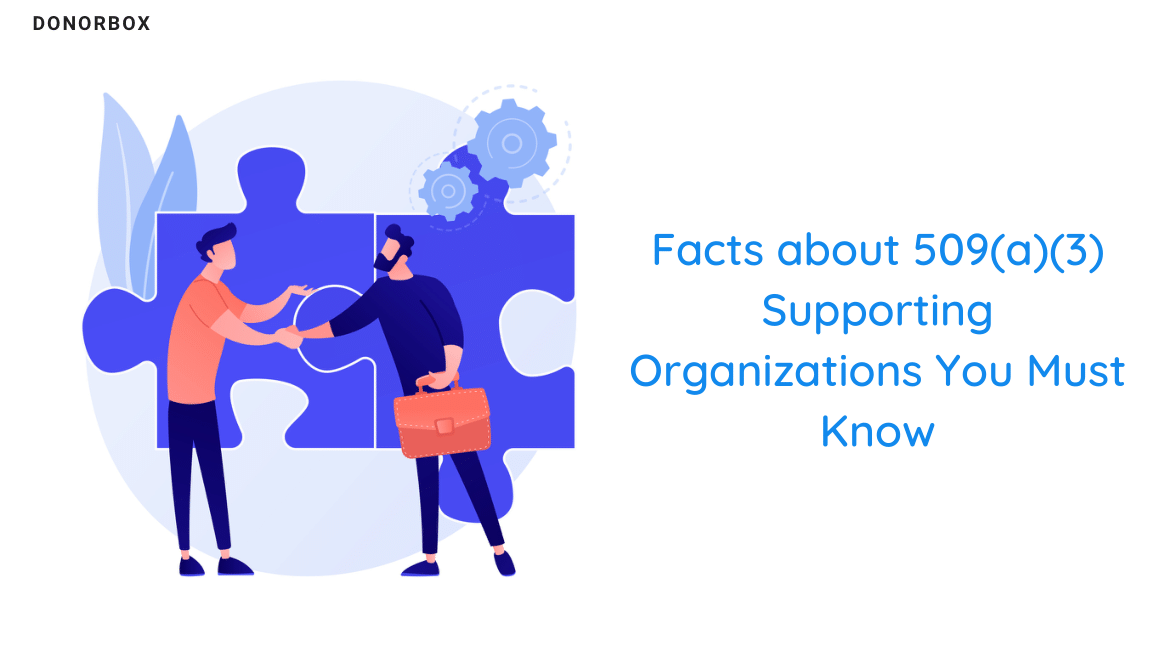The term “nonprofit” encompasses many different types of organizations. Some of these differences have to do with who it serves; other differences have to do with how they qualify with the Internal Revenue Service (IRS). This article will give you a better idea of a subcategory called the 509(a)(3) organization.
What is a 509(a)(3) Supporting Organization?

A 509a3 organization is a subcategory of 501c3. But unlike other 501c3 organizations, the 509a3 cannot exist on its own. These organizations have been created solely to support other organizations. These nonprofits either provide grants or perform the operations of the supported organization.
To qualify as a 509a3, the IRS says the organization “must have a relationship with its supported organization that ensures the supported organization is effectively supervising or paying particular attention to the supporting organization’s operations.”
Some real examples include Fitchburg State University Foundation that supports the Fitchburg State University and The Skoll Foundation that encourages social entrepreneurship with investments via the Silicon Valley Community Foundation.
The Different Tests of 509a3 Supporting Organizations

509a3 organizations come in 3 different types. All types must pass the same organizational, operational, and control test. When it comes to the relationship test, the differences between these types become significant.
1. Relationship test
The relationship test is how each type of 509a3 organization differs.
1.1 Type I
Type I must be operated, supervised, or controlled by its supported organization. The power in this relationship is similar to a parent-subsidiary relationship. Individuals who control the governing body of the supported organization cannot donate to its supporting organization.
1.2 Type II
Type II relationships are more like that between siblings. The way nonprofits do this is by having a majority of the directors or trustees from the supported organization serve as trustees and directors for the supporting organization.
1.3 Type III
These organizations can support and operate in connection with more than one publicly supported organization. Like Type I, supporting organizations cannot receive gifts from people who control the governing body of the supported organization.
2. Organizational test
A 509a3 is created solely to benefit or carry out the purpose of a 509a1 or 509a2 organization. When filling out an organization’s Articles of Incorporation, the nonprofit must state the specific organization(s) it supports. It is also vital that the nonprofit does not allow the organization to support any other public charities.
3. Operational test

The supporting organization must engage solely in activities that support or benefit its supported organization. These organizations can make direct grants to the supported organizations or provide grants, facilities, and services to those the supported organization benefits.
4. Control test
This control test addresses the ability of someone to impact or perform any act that affects the organization’s operations. Disqualified persons may not control a supporting organization directly or indirectly. Foundation managers who are disqualified persons due to being foundation managers are not treated as disqualified for this control test.
Additional Requirements for Type III Supporting Organizations
In addition to the 4 tests required for all 509a3 organizations, Type III nonprofits have additional requirements.

1. Notification requirement
Each Type III organization must provide annual reporting documentation to all organizations they support. This documentation includes:
- A written notice describing the amount of support given to the other organization during the previous tax year
- A copy of their recently filed Form 990 or 990EZ
- A copy of the supporting organization’s governing documents
All documentation must be postmarked or electronically transmitted by the last day of the fifth month following the close of the tax year.
2. Responsiveness test
Type III supporting organizations must prove they are responsive to the supported organization. To do this, the supported organization will appoint at least one officer, director, or trustee of the supporting organization. At least one member of the governing body of the supported organization must also serve as an officer, director, or trustee of the supporting organization.
3. Integral part test
Finally, Type III organizations are either functionally integrated (FISO) or non-functionally integrated (non-FISO). The way this is decided is through the integral part test.

3.1 FISO
Type III FISOs have fewer restrictions and requirements, but they must fall under one of the following 3 alternatives.
Alternative 1: Activities test
FISO organization activities must be direct furtherance activities and be conducted by the supporting organization. Fundraising, grantmaking, and managing non-exempt-use assets are not direct furtherance activities. An example of this type of organization is a food pantry created by a church or group of churches that provide food to the needy.
Alternative 2: Parent of supported organizations
Supporting organizations must be able to appoint most of the officers, directors, or trustees for each supported organization. The supporting organization must also direct the policies, programs, and activities of the supported organization.
Alternative 3: Supporting a governmental entity
Alternative 3 is for supporting organizations that support a governmental entity. These organizations must follow additional guidance provided in notice 2014-4.
3.2 Non-FISO
IRS requirements and regulations are much stricter for Non-FISO Type III supporting organizations. For more details on these restrictions, read more about the IRS integrated test.
3.2.1 Distribution requirement
Non-FISO Type III organizations must distribute more than 85% of their adjusted net income and 3.5% of their assets’ aggregate fair market value to one or more of its supported organizations.
3.2.2 Attentiveness requirement
The IRS requires that the supported organization pays attention to the supporting organization’s role in its operations. They can see this in a few different ways:
- The amount equals at least 10% of the supported organization’s total support
- The amount is essential for the organization to carry on a significant activity
- Attentiveness with facts and evidence
Annual Tax Filing Requirements for 509(a)(3) Supporting Organizations

509a3 supporting organizations must file Form 990 or 990EZ annually, even if they would otherwise fall within a filing exemption. This is true for organizations that have gross receipts equaling $50,000 or less, affiliates of governmental units, and church or church-affiliated organizations.
The below categories are exempt from tax filing requirements under certain conditions.
1. Integrated auxiliary of a church
An integrated auxiliary of a church must be both a 501c3 organization and be a public charity under code 501a1, a2, or a3. These organizations must also be affiliated with a church or convention or association of churches and receive financial support primarily from internal church sources instead of public or governmental sources. Men and women organizations, youth groups, seminaries, and mission societies are all exempt regardless of the source of their financial support.
2. Exclusively religious activities
Organizations that provide exclusively religious order activities do not have to file Form 990 or 990EZ.
3. Gross receipts
Organizations with gross receipts at $5,000 or below that support a 501c3 religious organization, do not have to file Form 990 or 990EZ. Organizations that fall under this requirement but not the first two must still file Form 990-N or voluntarily file Form 990 or 990EZ.
Final Thoughts

509a3 supporting organizations can vary substantially, but the IRS has created strict and detailed requirements and regulations to claim this status.
To learn more about starting a 501c3 organization or further details on creating your own nonprofit, tips and resources on fundraising, etc., visit our blog. If your organization is searching for an affordable option to collect donations and manage donors, learn more about Donorbox on our website.











